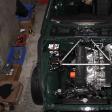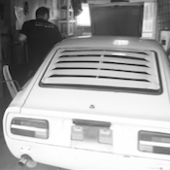Search the Community
Showing results for tags 'tuning'.
-
Hey guys, you might have seen my posts in the various facebook groups over the last couple of days, but finally I´ll post here too, after I gathered most infos about the commonly asked questions. I’ve a glass manufacturer on hand who will produce new glass for our S30 Z’s (2 seater) It will be thinner and therefore also lighter but still obtain all safety regulations including the E sign and also the DOT number. So fully street legal in Europe and the US including all necessary testing that goes with it. Some might think thinner means a weaker windshield and also a higher risk of damage due to stone chips or what not. I ask for a statement from the manufacturer which at least to me makes sense.... so due to the fact that it’s thinner it’s also more flexible and absorbs the impact better. As our cars are not relying on structure integrity of the windscreen, it also doesn’t change any rigidity of the car. Thicker and therefor harder glass is also more brittle. The windshield for example will be approximately 5kg lighter due to the reduction from 6,76mm to 3,96mm. We’re still looking into how to seal everything but it probably has to be glued into the window seal. Then we would still be able to use the standard gasket. But that’s also the case iaw the Nissan FSM, at least for the 280z. I’m looking for people who are also interested in new door glass and rear hatch glass as they have to build a new form for it. We need in total 10 pieces made to justify the cost for a form. The sides will be 3,15mm instead of stock 3,85mm. Same for the rear hatch window. Horizontal Heating will be possible in the aft one but can also ordered without heating. Vertical heating is still questionable due to low demand, probably. (another tool has to be made for "printing" it on the glass.) Prices are without TAX but including shipping in germany, for exact shipping quote send me your address via pm and I forward it to the manufacturer. Windshield: 390€ with 2x 1,6mm glass 240€ with 2x 2,1mm glass Still waiting on raw material for these ones... sadly...: Door and hatch glass: With 10 orders: 500-600€ a piece. With 20 orders 350€-450€ due to the tooling costs. These prices are very rough calculated as the manufacturer is still waiting for answers from their supplier regarding the blue tinted glass (like OEM) in the right thicknesses. So I hope they will go down by a lot. Should know more in that regard beginning of next week. Maybe it has to be clear, let’s see... Iaw the parts catalog at least windscreen and rear hatch glass are the same across 240/260/280z. Door windows have differences in the MJ, for now they would use a 78" 280z for the forms, I hope they´re able to use them for 240/260Z too, as the general form should be the same for the door glass, just the holes and the part which mates to the metallic window mechanism has another cutout... but lets see. Shipping and selling will be done through the manufacturer and is possible worldwide. Please comment for general interest. I´m only trying to get it going with the manufacturer. Let’s see if they actually start to produce it. Bigger group buys will get an additional 10-20% off. Alright, thats it 😄 comments welcome, please discuss the idea 🙂
- 10 replies
-
- glass
- lightweight
-
(and 2 more)
Tagged with:
-
Hello, since I am currently restoring my 1973 240z and the l24 engine will get pulled out I am considering doing some performance mods. I have found that installing a crank with a higher stroke is a common way to get some extra power but i am not sure if it would be smarter to use a regular l28 crank (like the l26 did i believe) or the diesel ld28 crank and if this would even fit/work? Thanks for the help in advance. Greetings from Germany.
-
I am attempting to tune my '71 with the old round top SUs. I performed a rudimentary (at best) carb tuning and then turned to the ignition. While tuning the engine I was able to get the it to idle well at 800 RPM and it had strong acceleration up to about 6K RPM and 90 MPH. (On a track only, of course! ?) But when I look at the ignition timing with a timing light, it shows that it is about 25-degrees BTDC! The distributor is at its limit of adjustment. Is it possible/recommended that I remove the distributor itself and move it by "one position" to fix the problem and get me back to the right range where I can make timing adjustments just loosening the distributor cap and adjusting? What is going on and how I can fix it? Thanks!
- 14 replies
-
- carburator
- timing
-
(and 1 more)
Tagged with:
-
Saw this and thought it might work for dual SUs, what do you guys think?
-
Disclaimer: I am by NO means a Weber Pro and this post is still a WIP (Work in Progress) Hello, my name is Mike and I've recently tackled my first set of Triple DCOE Webers project. Now, I spent hours reading all the manuals and following a few guides online, but none of them were particularly methodical in their approach and often just led to more confusion. I'm putting this guide together to, hopefully, help others who might not have much experience with these carbs or for those who (like me) prefer a Step-by-Step approach to figuring things out. This guide has been made possible with the help of those more knowledgeable than me. Thanks guys - you know who you are! If there's anything I need to clarify or add, let me know. Table of Contents I. Documentation II. Useful Links/Parts/Accessories III. Prologue IV. Choke/Venturi V. Main Jets, Emulsion Tubes, Air Correctors & Idle Jets VI. TBD I. Documentation DCOE Weber Carburetor Top-View Layout Weber Factory Tuning Manual - Download Link Power Tuning Webers (Des Hammil/Veloce Publishing) - Download Link Selection and Tuning of DCOE Weber Carbs (David Andrews ) - Download Link Weber DCOE Tuning Manual (Philippe Boursin) - Download Link II. Useful Links/Parts/Accessories http://www.redlineweber.com/ http://www.piercemanifolds.com/ http://www.carburetion.com/index.htm III. Prologue - The First Date First and foremost, it is essential that you know what you're working with. Setup a date with your newly acquired friends and spend a romantic evening just getting to know each other - perhaps light some candles and pour some wine while you're at it. In order to tune them properly, you need to know what sort of equipment your carbs are packing. IV. Choke/Venturi - Step One - Removal Let's start off by determining the size of the chokes/venturis. (If carbs don't have filters on them, skip to Step 1D) If the carbs are already out, the easiest way is to shine some light down the carb and see if you spot the engraved number. If you can't see the number or if you want to replace the chokes, then follow these steps. 1A - Unscrew the airbox/filter (If applicable) 1B - Underneath there are four (8mm) bolts holding in the housing. I already took off one of the studs. 1C - Remove Gasket (If applicable) 1D - Unscrew the this little fella (11mm) sitting on the bottom corner of each side of the carburetor. This holds the auxiliary venturi in place. 1E - Once the screw is removed, the aux. venturi should slip right out. 1F - Make a note of the little indent where the screw holds the aux. venturi in place. You're gonna have to put it back the same way for it to seat properly 1G - You should be able to see the chokes now, but we're gonna replace the 28's with a different size. 1H - Unscrew this fella (I used a flathead) to allow the choke to slide out. 1I - If you're having some trouble getting the choke/venturi out, then open the butterflies and push it out from the opposite side. It'll otherwise slide out IV. Choke/Venturi - Step Two - Assembly Alright, so now we have removed the choke - it's time to replace them! Here's the old 28 next to the new 34 that is going in. 2A - See these notches? You want to make sure that they line up properly in the carb. Looking at the carb from the front, the left choke lines up at 12 & 3, while the right choke lines up at 12 & 9 (Left choke lined up at 12 & 3) 2B - Re-insert the screw and make sure it sits firm. I had some trouble getting the right angle on some of them, so just make sure it's lined up properly. 2C - The aux. venturi should slide right in. Remember that little indent from before? Make sure it lines up properly with where the screw goes. 2D - Screw the little guy (11mm) back in and double check to make sure the aux. venturi is seated properly 2E - Do one final inspection to make sure everything is sitting right and then continue to put your gasket and filter back on. Personally, I went with these stacks. They slide right in and uses little clips that slide into the studs to hold them in. V. Main Jets, Air Correctors, Emulsion Tubes & Idle Jets WIP - Work in Progress
-
- 1 review
-
- carburettors
- dcoe
- (and 4 more)




